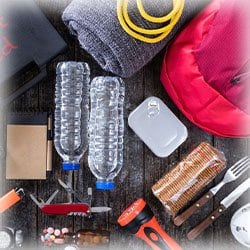National Preparedness Month
 Prepare for any type of emergency by having a well-stocked supply kit.
Prepare for any type of emergency by having a well-stocked supply kit.
No matter where you live, you’re likely at risk of experiencing some type of natural or man-made disaster. Whether flooding, fires, tornadoes, earthquakes, hurricanes, blizzards or other types of storms, being prepared can help you get through anything that comes your way.
One way to prepare for these disasters is to have an evacuation plan. This will allow you to figure out in advance what you will do if you need to leave your home quickly due to weather or other types of disasters. The plan may include where you’ll meet, where you’ll go, how you’ll communicate and what you’ll bring with you. Having this plan in place can help ease your mind and makes it easier to make well-thought-out decisions when you’re not in the midst of an emergency.
While this plan is a key aspect of preparing for emergencies, it’s also extremely important to put together a supply kit to keep in your home in case you can’t get out for a few days. Sometimes events keep people stuck in their homes for a while, potentially with no access to power or water. “Having the right supplies on hand can help you get through that time more safely and comfortably,” said Sahir Mahir Gharib MD, a PIH Health family medicine physician.
Here are 21 things you should include in your disaster supplies kit (make sure you have enough for every member of your household for 3 days):
- Non-perishable food
- Water – one gallon per person per day
- Prescription and over-the-counter medications
- First aid kit
- Hygiene and sanitation items – toilet paper, sanitizing wipes, toothpaste, etc.
- Special needs items, such as eyeglasses, hearing aids, canes or assistive devices
- Items for babies (if appropriate) – diapers, formula, bottles, pacifiers, toys, etc.
- Items for pets (if appropriate) – food, bowls, leashes, toys, etc.
- Extra clothing – keep in mind that you may not have heat or air conditioning
- Extra shoes – include boots in case you need to walk through water, mud, debris or snow
- Bedding
- Can opener
- Disposable plates, cups and silverware
- Cleaning supplies
- Battery-operated radio
- Flashlights
- Extra batteries
- Phone chargers
- Whistle – in case you need to get someone’s attention
- Photocopies of ID cards – license, medical card, etc.
- Cash
Your disaster supply kit should be kept in an area of your house where you are likely to shelter in place during an emergency. The supplies should be kept in an easy-to-carry waterproof container in case you need to evacuate your home so you can quickly grab the supplies on the way out.
A disaster supplies kit cannot simply be assembled and then forgotten about. Needs change (you may have more family members or a new pet). Food and medication expire. Batteries die. That’s why it’s important to take inventory of your disaster supplies kit every 6 months. Use the food and medication you stored before it goes bad and replace it with a new supply. Update any items you need so you’re always ready to keep your family safe, fed and cared for during an emergency.
Copyright 2023 © Baldwin Publishing, Inc. Health eCooks® is a registered trademark of Baldwin Publishing, Inc. Cook eKitchen™ is a designated trademark of Baldwin Publishing, Inc. Any duplication or distribution of the information contained herein without the express approval of Baldwin Publishing, Inc. is strictly prohibited.
Date Last Reviewed: July 20, 2023
Editorial Review: Andrea Cohen, Editorial Director, Baldwin Publishing, Inc. Contact Editor
Medical Review: Perry Pitkow, MD
Learn more about Baldwin Publishing Inc. editorial policy, privacy policy, ADA compliance and sponsorship policy.
No information provided by Baldwin Publishing, Inc. in any article is a substitute for medical advice or treatment for any medical condition. Baldwin Publishing, Inc. strongly suggests that you use this information in consultation with your doctor or other health professional. Use or viewing of any Baldwin Publishing, Inc. article signifies your understanding and agreement to the disclaimer and acceptance of these terms of use.